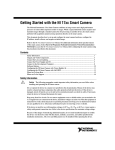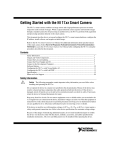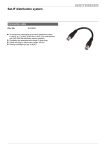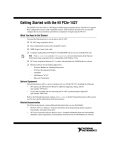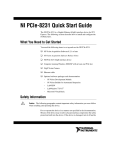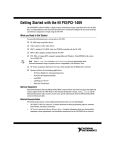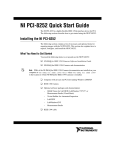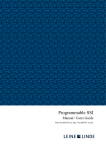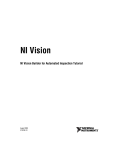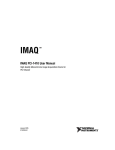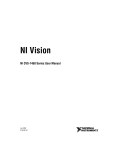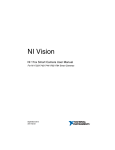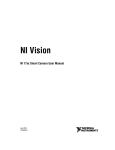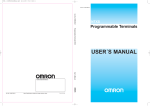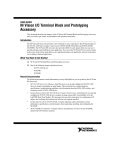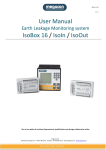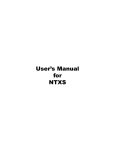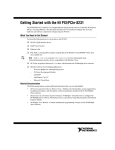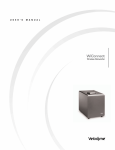Download Getting Started with the NI 17xx Smart Camera
Transcript
Getting Started with the NI 17xx Smart Camera The National Instruments 17xx Smart Camera combines an image sensor and a high-performance processor to return either inspection results or images. While a typical industrial camera acquires and transmits images through a standard camera bus for processing on another device, the smart camera performs both acquisition and processing operations directly on the smart camera. This document describes how to set up and configure the smart camera hardware, configure the IP address, install software, and acquire an initial image. Refer to the NI 17xx Smart Camera User Manual for information about specific features and specifications of the smart camera. Select Start»All Programs»National Instruments»Vision» Documentation»NI-IMAQ to access the NI 17xx Smart Camera User Manual after configuring the smart camera using the procedures described in this document. Unpack and Verify Components Remove the NI Smart Camera from the package and inspect the device for any sign of damage. Notify National Instruments if the device appears damaged in any way. Do not use a damaged device. For safety and compliance information, refer to the specifications in the NI 17xx Smart Camera User Manual. Required Components This section describes the hardware and software components necessary to set up and use the NI Smart Camera. Hardware The following hardware components are included in the NI Smart Camera kit: ❑ NI 17xx Smart Camera ❑ 5-position lighting connector (additional/replacement plugs for use with the lighting connector are available from NI, part number 780260-01) In addition to the items included in the smart camera kit, the following components are necessary to set up and configure the smart camera: ❑ One or two CAT 5 10/100Base-TX or CAT 5e or CAT 6 1000Base-T Ethernet cables. One Ethernet cable is required to connect the smart camera directly to the development computer. Two Ethernet cables are required to connect the smart camera to the development computer through a network. Note A CAT 5e or CAT 6 1000Base-T Ethernet cable is required to achieve maximum 1,000 Mbps (Gigabit) Ethernet performance. CAT 5e and CAT 6 Ethernet cables adhere to higher electrical standards required for Gigabit Ethernet communication. CAT 5 cables are not guaranteed to meet the necessary electrical requirements. While CAT 5 cables may appear to work at 1,000 Mbps in some installations, CAT 5 cables are likely to cause increased bit errors resulting in degraded or unreliable network performance. ❑ One of the following power supply options: Use the smart camera only with a 24 VDC, UL listed, limited power source (LPS) supply. The power supply will bear the UL listed mark, LPS. The power supply must also meet any safety and compliance requirements for the country of use. Caution – NI desktop power supply (part number 780237-01) and power supply cord. Refer to ni.com for the power supply cord part number specific to your region and ordering information. – Any 24 VDC, +20%/–15% (IEC 1311) power supply and one of the following cable options for connecting to the power supply and I/O: • 15-pin D-SUB pigtail cable, 5 m (part number 197818-05) • 15-pin D-SUB to 15-pin D-SUB cable, 2 m (part number 197817-02) or 5 m (part number 197817-05), and a 15-pin D-SUB terminal block Getting Started with the NI 17xx 2 ni.com ❑ ❑ Standard C-mount lens. Other lenses available from NI are listed in the Optional Components section. Development computer running Windows Vista/XP/2000 Software Use one of the following application development environments to develop NI Smart Camera applications. Refer to Table 1 for the Vision Builder for Automated Inspection (Vision Builder AI) information or to Table 2 for LabVIEW and LabVIEW module information. Table 1. NI Vision Builder AI Minimum Versions NI Smart Camera NI Vision Builder AI Version (Included) NI 1722 3.5 or later NI 1742 NI 1744 3.6 or later NI 1762 NI 1764 Table 2. LabVIEW and Necessary Modules Minimum Versions Smart Camera NI 1722 NI 1742 NI 1744 NI 1762 LabVIEW LabVIEW Real-Time Vision Development Module Vision Acquisition Software 8.5 or later 8.5 or later 8.5 or later 8.6 or later 8.5.1 or later 8.5.1 or later 8.6 or later 8.6 or later NI 1764 Optional Components National Instruments offers a variety of accessories for use with the NI Smart Camera, including the following items: • Lenses – 8 mm (part number 780024-01) – 12 mm (part number 780025-01) © National Instruments Corp. 3 Getting Started with the NI 17xx • • • – 16 mm (part number 780026-01) – 25 mm (part number 780027-01) Current controlled lights – Back light (part number 780221-01) – Ring light (part number 780222-01) – Broad area linear light array (part number 780223-01) – Spot light (part number 780224-01) Mounting brackets – Tripod adapter plate (part number 780239-01) – Panel mount (part number 780240-01) Accessories – NI 17xx unshielded screw terminal breakout with 2 m cable (part number 780261-01) – NI Smart Camera I/O accessory (part number 780443-01) Visit ni.com or contact the branch office nearest you for more information about these and other products. Connect the Lens and Lighting Complete the following steps to connect a standard C-mount lens and external lighting accessories to the NI Smart Camera. 1. Remove the lens cover from the smart camera. 2. Gently align the threads on the base of the lens with the threads on the sensor opening, and twist clockwise until the lens is securely attached. Lighting The NI Smart Camera offers two options for controlling a light—a Direct Drive internal lighting controller, or 5 V TTL or 24 V external strobe generation for use with a third-party lighting controller. Refer to the NI 17xx Smart Camera User Manual for information about using the smart camera with a light. Note The Direct Drive lighting controller is not available on NI 1722 smart cameras. NI 1722 smart cameras support only 5 V TTL or 24 V external strobe generation. Getting Started with the NI 17xx 4 ni.com Connect the Power Supply and I/O To connect a power supply to the NI Smart Camera, complete the steps listed in one of the following sections. Refer to the Power Only section to connect the NI desktop power supply directly to the smart camera with no additional I/O. Refer to the Power with Additional I/O section to connect a third-party power supply or if your application requires I/O, such as a trigger signal. Use the smart camera only with a 24 VDC, UL listed, limited power source (LPS) supply. The power supply will bear the UL listed mark, LPS. The power supply must also meet any safety and compliance requirements for the country of use. Caution Power Only Refer to Figure 1 while completing the following steps to connect the NI desktop power supply to the NI Smart Camera with no additional I/O. 2 1 1 NI Smart Camera 2 Power Supply Figure 1. Connecting the NI Smart Camera to the NI Desktop Power Supply 1. Connect and secure the 15-pin D-SUB connector on the NI desktop power supply to the POWER-I/O connector on the smart camera. 2. Plug the power supply power cord into the power supply. 3. Plug the power supply into an outlet. When power is first applied to the smart camera, the POWER LED flashes red for one second while internal systems power up. The POWER LED then lights green when power is correctly wired to the smart camera. © National Instruments Corp. 5 Getting Started with the NI 17xx Power with Additional I/O National Instruments provides the following two cable options for connecting a third-party power supply and I/O to the NI Smart Camera. • Terminal block with a 15-pin D-SUB connector, such as the NI Smart Camera I/O Accessory, and a 15-pin D-SUB to 15-pin D-SUB cable • 15-pin D-SUB pigtail cable Refer to Figure 2 while completing the following steps to connect a third-party power supply and I/O to the smart camera using either a terminal block or the pigtail cable. 1 3 2 1 NI Smart Camera 2 15-Pin D-SUB to 15-Pin D-SUB Cable 4 3 Optional Terminal Block 4 Power Supply Figure 2. Connecting the NI Smart Camera to a Third-Party Power Supply 1. Connect and secure the 15-pin D-SUB connector on your cable to the POWER-I/O connector on the smart camera. 2. If you are using a terminal block, connect the cable to the terminal block. 3. Connect the +24 V signal from the cable or terminal block to the corresponding signal on the power supply. Table 3 shows the pin locations for the POWER-I/O connector and lists the signal names and pin numbers. The table also lists wire colors for the National Instruments 15-pin D-SUB pigtail cable. Cables from another vendor may have different wire colors. Getting Started with the NI 17xx 6 ni.com Table 3. NI Smart Camera POWER-I/O Connector Signal Descriptions Connector Diagram 11 6 15 (COM) 10 1 5 (+24 V) Signal Name Pin Number Wire Color +24 V 5 Red COM 15 Black RS_232TXD 10 Pink RS_232RXD 14 Black/White TrigIn+ IsoIn(0)+ 2 Brown IsoIn(1)+ 8 Orange TrigIn– IsoIn(0)– IsoIn(1)– 12 Light Green IsoOut(0)+ 6 Yellow IsoOut(0)– 1 Green IsoOut(1)+ 11 Light Blue IsoOut(1)– 7 Gray PhaseA+ 3 Blue PhaseA– 13 Brown/White PhaseB+ 9 Purple PhaseB– 4 White 4. Connect the COM signal from the cable or terminal block to the corresponding signal on the power supply. 5. Connect any additional I/O signals necessary for your application to the appropriate signal on the cable or terminal block. Refer to Table 3 for pin information. 6. If necessary, connect the power cord to the power supply. 7. Plug the power supply into an outlet. When power is first applied to the smart camera, the POWER LED flashes red for one second while internal systems power up. The POWER LED then lights green when power is correctly wired to the smart camera. © National Instruments Corp. 7 Getting Started with the NI 17xx Connect to the Development Computer The NI Smart Camera can connect to the development computer directly or through a network using an Ethernet cable. The smart camera provides automatic MDI/MDI-X correction, so you can use either a standard Ethernet cable or a crossover Ethernet cable to connect to the development computer. If the development computer is configured on a network, you must configure the smart camera on the same network subnet as the development computer to connect through the network. To prevent data loss and to maintain the integrity of your Ethernet installation, do not use a cable longer than 100 m. National Instruments recommends using a shielded twisted pair Ethernet cable for maximum signal integrity. Caution Firewall Configuration If your firewall is controlled remotely or you are unsure about configuring the firewall, contact your network administrator. Refer to Appendix B, Troubleshooting, of the NI 17xx Smart Camera User Manual to troubleshoot network configuration issues. Direct Connection To connect the NI Smart Camera directly to the development computer, refer to Figure 3 and complete the following steps. Getting Started with the NI 17xx 8 ni.com 2 1 1 Connecting an Ethernet Cable to Port 1 on the NI Smart Camera 2 Connecting an Ethernet Cable to an Ethernet Port on the Development Computer Figure 3. Connecting the NI Smart Camera Directly to the Development Computer 1. Use an Ethernet cable to connect from the Ethernet port on the development computer to Ethernet port 1 on the smart camera. 2. Configure the network card on the development computer to use a static IP address. Refer to your Windows networking documentation for information about configuring a static IP address. The smart camera is now connected directly to the development computer. Network Connection To connect the NI Smart Camera to the development computer through a network, refer to Figure 4 and complete the following steps. © National Instruments Corp. 9 Getting Started with the NI 17xx 3 2 1 1 Connecting an Ethernet Cable to Port 1 on the NI Smart Camera 2 Ethernet Hub or Other Network Port 3 Connecting an Ethernet Cable to an Ethernet Port on the Development Computer Figure 4. Connecting the NI Smart Camera to the Development Computer Through a Network 1. Verify that the development computer is connected to the network and powered on. 2. Using an Ethernet cable, connect from an Ethernet hub or other network port to Ethernet port 1 on the smart camera. The smart camera is now connected to the development computer through a network. Subnet Considerations To configure the NI Smart Camera, it must reside on the same subnet as the development computer. Once the smart camera is configured, as described in the Configuring the NI Smart Camera with Vision Builder AI section and the Configuring the NI Smart Camera with LabVIEW section, other subnets can be used to access it. To use the smart camera on a subnet other than the one on which the development computer resides, first connect and configure the smart camera on the same subnet as the development computer. Next, physically move the smart camera to the other subnet. Contact your network administrator for assistance in determining which network ports reside on the same subnet. Getting Started with the NI 17xx 10 ni.com Software Options National Instruments provides two options for developing applications for the NI Smart Camera. Vision Builder for Automated Inspection • or LabVIEW LabVIEW Real-Time Module NI Vision Development Module NI Vision Acquisition Software NI Vision Builder for Automated Inspection (Vision Builder AI)—Interactive, menu-driven configuration software for developing, benchmarking, and deploying machine vision applications. The latest version of Vision Builder AI is included with the smart camera. To use Vision Builder AI to configure the smart camera and develop your application, complete the instructions in the Configuring the NI Smart Camera with Vision Builder AI section of this document. • NI LabVIEW—Graphical programming environment for developing flexible and scalable applications. The following add-on modules are required for developing machine vision applications: – LabVIEW Real-Time Module—Programming library for developing distributed, deterministic applications. – NI Vision Development Module—Programming library for developing machine vision and scientific imaging applications. – NI Vision Acquisition Software—Includes NI-IMAQ driver software for acquiring images and controlling I/O using the smart camera. The latest version of NI Vision Acquisition software is included with the smart camera. To use LabVIEW to configure the smart camera and develop your application, complete the instructions in the Configuring the NI Smart Camera with LabVIEW section of this document. © National Instruments Corp. 11 Getting Started with the NI 17xx The installation and configuration process for each development environment is different. Complete only the instructions for your chosen development environment. Note Configuring the NI Smart Camera with Vision Builder AI Complete the following steps to install Vision Builder AI and configure the NI Smart Camera. 1. Install and activate Vision Builder AI on the development computer. Refer to the NI Vision Builder for Automated Inspection Readme for installation instructions. 2. Launch Vision Builder AI. 3. On the Vision Builder AI welcome screen, select the NI Smart Camera in the list of targets. If the NI Smart Camera does not appear in the list of targets, refer to the Subnet Considerations section of this document and Appendix B, Troubleshooting, of the NI 17xx Smart Camera User Manual for information about subnets and troubleshooting smart camera configuration issues. 4. Click Install Software. The Remote Target Configuration Wizard launches in a new window. 5. In the Name field, enter a name for the device. Use the Description field to enter any additional information or a brief description of the device. Device names are limited to 31 characters with no spaces or special characters, except hyphens. The first and last characters must be alphanumeric. 6. Click Next. Configure the IP Address 1. If the network is configured to issue IP addresses using DHCP, select Obtain IP address from DHCP server. Otherwise, configure the IP address manually by selecting Edit the IP settings and clicking Suggest Values. 2. If you want to prevent other users from configuring the smart camera, select Enable Password and click Set Password to set up password protection. 3. Click Next. Getting Started with the NI 17xx 12 ni.com Install Software on the NI Smart Camera Complete the following steps to install software from the development computer to the NI Smart Camera. 1. In the Remote Target Configuration Wizard, enable the Update Target Software checkbox. 2. Click the Browse button next to the Software Image to Install on the Target control. 3. Navigate to the Vision Builder AI software image you want to use, and click OK. Software images provided by National Instruments are installed to the <Vision Builder AI>\ RT Images directory, where <Vision Builder AI> is the location where Vision Builder AI is installed. 4. Click OK to apply the IP configuration settings and download software to the smart camera. 5. Click OK to close the Remote Target Configuration Successful dialog box. Acquire an Image Complete the following steps to acquire an image using Vision Builder AI. 1. On the Vision Builder AI welcome screen, select the NI Smart Camera in the list of targets. 2. Click Acquire Image (Smart Camera) Example to open the image acquisition example in the Vision Builder AI Configuration Interface. 3. Click the Run State Once button to acquire a single image. 4. In the State Configuration Window, select the Acquire Image (Smart Camera) step. 5. Click the Edit Step button. The property page for the step opens. 6. Use the controls on the Main, Trigger, Lighting, and Advanced tabs to configure any additional settings necessary for your application. 7. Click OK to save the step configuration. The smart camera is now configured and acquiring images. Use Vision Builder AI to add and configure additional inspection steps to create your application. Refer to the Where to Go from Here section for a list of documentation and other resources to help you set up and use the smart camera in an application. © National Instruments Corp. 13 Getting Started with the NI 17xx Configuring the NI Smart Camera with LabVIEW Complete the following steps to install LabVIEW, the LabVIEW Real-Time Module, the NI Vision Development Module, and NI Vision Acquisition Software and configure the NI Smart Camera. Install the software in the following order: 1. LabVIEW—Refer to the LabVIEW Release Notes for installation instructions for LabVIEW and system requirements for the LabVIEW software. Refer to the LabVIEW Upgrade Notes for additional information about upgrading to the most recent version of LabVIEW. Documentation for LabVIEW is available by selecting Start»All Programs»National Instruments»LabVIEW» LabVIEW Manuals. 2. LabVIEW Real-Time Module—Refer to the LabVIEW Real-Time Module Release and Upgrade Notes for installation instructions and information about getting started with the LabVIEW Real-Time Module. Documentation for the LabVIEW Real-Time Module is available by selecting Start»All Programs»National Instruments»LabVIEW»LabVIEW Manuals. 3. NI-IMAQ—Refer to the NI Vision Acquisition Software Release Notes on the NI Vision Acquisition Software installation media for system requirements and installation instructions for the NI-IMAQ driver. Documentation for the NI-IMAQ driver software is available by selecting Start»All Programs»National Instruments» Vision»Documentation»NI-IMAQ. 4. NI Vision Development Module—Refer to the NI Vision Development Module Readme on the NI Vision Development Module installation media for system requirements and installation instructions. Documentation for the NI Vision Development Module is available by selecting Start»All Programs»National Instruments»Vision»Documentation»NI Vision. Getting Started with the NI 17xx 14 ni.com Configure the IP Address You can assign the NI Smart Camera a static IP address or configure it to automatically acquire an IP address from a DHCP server. Complete the following steps to configure an IP address for the NI Smart Camera. 1. Launch Measurement & Automation Explorer (MAX), the National Instruments configuration utility, by double-clicking the Measurement & Automation icon on the desktop, or selecting Start»All Programs»National Instruments» Measurement & Automation. 2. Expand the Remote Systems branch of the configuration tree, and select the device you want to configure. To uniquely identify multiple unconfigured devices, connect and configure one device at a time. Refer to the Subnet Considerations section of this document and Appendix B, Troubleshooting, of the NI 17xx Smart Camera User Manual for information about subnets and troubleshooting smart camera configuration issues. 3. In the Name field, enter a name for the device. Use the Comment field to enter any additional information or a brief description of the device. 4. Device names are limited to 31 characters with no spaces or special characters, except hyphens. The first and last characters must be alphanumeric. 5. Verify the IP address configuration. The IP address is either a network address, an automatic private IP address (169.254.x.x), or 0.0.0.0, depending on how the network is configured to issue network addresses. • If the network is configured to issue IP addresses using DHCP, select Obtain IP address from DHCP server. • Otherwise, configure the IP address manually. Select Edit the IP settings, click Suggest Values, and click OK. Note If the smart camera IP address is 169.254.x.x or 0.0.0.0, the smart camera is only accessible from the local subnet. To access the smart camera from a remote subnet, configure the smart camera to obtain an IP address from a DHCP server or manually assign a static IP address. © National Instruments Corp. 15 Getting Started with the NI 17xx 6. If you want to prevent other users from resetting the smart camera, click the Lock button on the MAX toolbar to set up password protection for the smart camera. To require users to enter the password before restarting the smart camera, enable the Password-protect Resets checkbox. 7. Click Apply on the MAX toolbar. 8. When prompted, click Yes to restart the smart camera. The initialization process may take several minutes. Install Software on the NI Smart Camera Complete the following steps to install software from the development computer to the NI Smart Camera. 1. In the Remote Systems branch of the MAX configuration tree, expand the folder for your device and select Software. 2. Click Add/Remove Software on the MAX toolbar to launch the LabVIEW Real-Time Software Wizard. 3. Select LabVIEW Real-Time, NI Vision RT, NI-IMAQ RT, NI-IMAQ Server, and any additional software necessary for your application, as shown in Figure 6. Figure 5. Selecting Software to Install in MAX 4. Click Next. 5. Verify your software installation choices, and click Next. 6. When the installation is complete, click Finish. Getting Started with the NI 17xx 16 ni.com Acquire an Image Complete the following steps to acquire an image using MAX. 1. In the Remote Systems branch of the MAX configuration tree, expand the folder for your device. 2. Click img0:NI 17xx, where 17xx is replaced by the actual model number of your smart camera. 3. Click Snap to acquire a single image, or click Grab to acquire continuous images. Click Grab again to stop a continuous acquisition. 4. Use the controls on the Sensor, Triggering, Lighting, and LUT tabs to adjust the acquisition settings. The NI Smart Camera is now configured and acquiring images. Use LabVIEW to create your application. Refer to the Where to Go from Here section for a list of documentation and other resources to help you set up and use the smart camera in an application. Where to Go from Here The following documents and resources contain information you may find helpful as you set up and use the NI Smart Camera in an application. Refer to the NI 17xx Smart Camera User Manual for detailed information about: • Power and I/O requirements • The image sensor and scan modes • Exposure time and field of view • The Direct Drive Lighting Controller and external lighting controllers • Acquiring images with the smart camera and calculating the maximum frame rate • Understanding the LED indicators and configuring the DIP switches • Ethernet connections • Smart camera specifications • Troubleshooting network, firewall, software, and power issues © National Instruments Corp. 17 Getting Started with the NI 17xx Additional Resources for Vision Builder for Automated Inspection Users Refer to the NI Vision Builder for Automated Inspection Tutorial to learn how to perform basic machine vision techniques using Vision Builder AI. You can access the NI Vision Builder for Automated Inspection Tutorial and other documentation by selecting Start»All Programs»National Instruments»Vision Builder AI»Documentation. You can also access context help within Vision Builder AI by clicking the Show Context Help button on the Vision Builder AI toolbar. Examples of common Vision Builder AI inspections are installed to the <Vision Builder AI>\Examples directory. Visit the NI Developer Zone at ni.com/zone for the latest example programs, tutorials, technical presentations, and a community area where you can share ideas, questions, and source code with developers around the world. Additional Resources for LabVIEW Users Documentation for LabVIEW and the LabVIEW Real-Time Module is available from the Help menu on the LabVIEW toolbar. You can access documentation for the NI Vision Development Module by selecting Start»All Programs»National Instruments»Vision»Documentation»NI Vision. Documentation for the NI-IMAQ driver software is available by selecting Start»All Programs»National Instruments»Vision» Documentation»NI-IMAQ. Documentation for the MAX configuration software is available from the Help menu on the MAX toolbar. Specific information about using MAX with NI Vision hardware is available by selecting Help»Help Topics»NI Vision»NI-IMAQ. Examples of image acquisitions and common machine vision inspections are installed to the <LabVIEW>\Examples\IMAQ and <LabVIEW>\Examples\Vision directories, where <LabVIEW> is the location where LabVIEW is installed. Visit the NI Developer Zone at ni.com/zone for the latest example programs, tutorials, technical presentations, and a community area where you can share ideas, questions, and source code with developers around the world. Getting Started with the NI 17xx 18 ni.com Safety Information The following paragraphs contain important safety information you must follow when installing and operating the NI smart camera. Caution Do not operate the device in a manner not specified in the documentation. Misuse of the device may result in a hazard and may compromise the safety protection built into the device. If the device is damaged, turn it off and do not use it until service-trained personnel can check its safety. If necessary, return the device to National Instruments for repair. Keep away from live circuits. Do not remove equipment covers or shields unless you are trained to do so. If signal wires are connected to the device, hazardous voltages can exist even when the equipment is turned off. To avoid a shock hazard, do not perform procedures involving cover or shield removal unless you are qualified to do so. Disconnect all field power prior to removing covers or shields. If the device is rated for use with hazardous voltages (>30 Vrms, 42.4 Vpk, or 60 Vdc), it may require a safety earth-ground connection wire. Refer to the device specifications for maximum voltage ratings. Because of the danger of introducing additional hazards, do not install unauthorized parts or modify the device. Use the device only with the chassis, modules, accessories, and cables specified in the installation instructions. All covers and filler panels must be installed while operating the device. Do not operate the device in an explosive atmosphere or where flammable gases or fumes may be present. Operate the device only at or below the pollution degree stated in the specifications. Pollution consists of any foreign matter—solid, liquid, or gas—that may reduce dielectric strength or surface resistivity. The following is a description of pollution degrees. • Pollution Degree 1—No pollution or only dry, nonconductive pollution occurs. The pollution has no effect. • Pollution Degree 2—Normally only nonconductive pollution occurs. Occasionally, nonconductive pollution becomes conductive because of condensation. © National Instruments Corp. 19 Getting Started with the NI 17xx • Pollution Degree 3—Conductive pollution or dry, nonconductive pollution occurs. Nonconductive pollution becomes conductive because of condensation. Clean the device and accessories by brushing off light dust with a soft, nonmetallic brush. Remove other contaminants with a stiff, nonmetallic brush. The unit must be completely dry and free from contaminants before returning it to service. You must insulate signal connections for the maximum voltage for which the device is rated. Do not exceed the maximum ratings for the device. Remove power from signal lines before connection to or disconnection from the device. National Instruments measurement products may be classified as either Measurement Category I or II. Operate products at or below the Measurement Category level specified in the hardware specifications. Caution Measurement Category1: Measurement circuits are subjected to working voltages2 and transient stresses (overvoltage) from the circuit to which they are connected during measurement or test. Measurement (Installation3) Category establishes standardized impulse withstand voltage levels that commonly occur in electrical distribution systems. The following is a description of Measurement Categories: • Measurement Category I is for measurements performed on circuits not directly connected to the electrical distribution system referred to as MAINS4 voltage. This category is for measurements of voltages from specially protected secondary circuits. Such voltage measurements include signal levels, special equipment, limited-energy parts of equipment, circuits powered by regulated low-voltage sources, and electronics. • Measurement Category II is for measurements performed on circuits directly connected to the electrical distribution system. This category refers to local-level electrical distribution, such 1 Measurement Categories as defined in electrical safety standard IEC 61010-1. 2 Working voltage is the highest rms value of an AC or DC voltage that can occur across any particular insulation. 3 Measurement Category is also referred to as Installation Category. 4 MAINS is defined as the (hazardous live) electrical supply system to which equipment is designed to be connected for the purpose of powering the equipment. Suitably rated measuring circuits may be connected to the MAINS for measuring purposes. Getting Started with the NI 17xx 20 ni.com as that provided by a standard wall outlet (e.g., 115 V for U.S. or 230 V for Europe). Examples of Measurement Category II are measurements performed on household appliances, portable tools, and similar products. • Measurement Category III is for measurements performed in the building installation at the distribution level. This category refers to measurements on hard-wired equipment such as equipment in fixed installations, distribution boards, and circuit breakers. Other examples are wiring, including cables, bus-bars, junction boxes, switches, socket-outlets in the fixed installation, and stationary motors with permanent connections to fixed installations. • Measurement Category IV is for measurements performed at the primary electrical supply installation (<1,000 V). Examples include electricity meters and measurements on primary overcurrent protection devices and on ripple control units. Where to Go for Support The National Instruments Web site is your complete resource for technical support. At ni.com/support you have access to everything from troubleshooting and application development self-help resources to email and phone assistance from NI Application Engineers. National Instruments corporate headquarters is located at 11500 North Mopac Expressway, Austin, Texas, 78759-3504. National Instruments also has offices located around the world to help address your support needs. For telephone support in the United States, create your service request at ni.com/support and follow the calling instructions or dial 512 795 8248. For telephone support outside the United States, contact your local branch office: Australia 1800 300 800, Austria 43 662 457990-0, Belgium 32 (0) 2 757 0020, Brazil 55 11 3262 3599, Canada 800 433 3488, China 86 21 5050 9800, Czech Republic 420 224 235 774, Denmark 45 45 76 26 00, Finland 358 (0) 9 725 72511, France 01 57 66 24 24, Germany 49 89 7413130, India 91 80 41190000, Israel 972 3 6393737, Italy 39 02 41309277, Japan 0120-527196, Korea 82 02 3451 3400, Lebanon 961 (0) 1 33 28 28, Malaysia 1800 887710, Mexico 01 800 010 0793, © National Instruments Corp. 21 Getting Started with the NI 17xx Netherlands 31 (0) 348 433 466, New Zealand 0800 553 322, Norway 47 (0) 66 90 76 60, Poland 48 22 328 90 10, Portugal 351 210 311 210, Russia 7 495 783 6851, Singapore 1800 226 5886, Slovenia 386 3 425 42 00, South Africa 27 0 11 805 8197, Spain 34 91 640 0085, Sweden 46 (0) 8 587 895 00, Switzerland 41 56 2005151, Taiwan 886 02 2377 2222, Thailand 662 278 6777, Turkey 90 212 279 3031, United Kingdom 44 (0) 1635 523545 Getting Started with the NI 17xx 22 ni.com LabVIEW, National Instruments, NI, ni.com, the National Instruments corporate logo, and the Eagle logo are trademarks of National Instruments Corporation. Refer to the Trademark Information at ni.com/trademarks for other National Instruments trademarks. Other product and company names mentioned herein are trademarks or trade names of their respective companies. For patents covering National Instruments products/technology, refer to the appropriate location: Help»Patents in your software, the patents.txt file on your media, or the National Instruments Patent Notice at ni.com/patents. © 2007–2010 National Instruments Corp. All rights reserved. 372351D-01 Oct10























